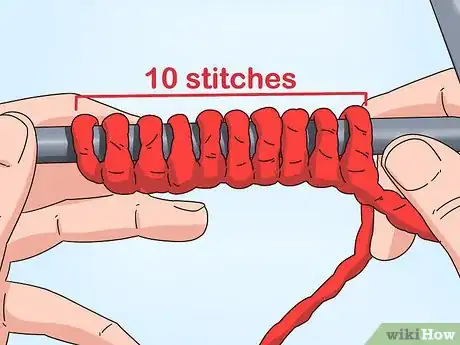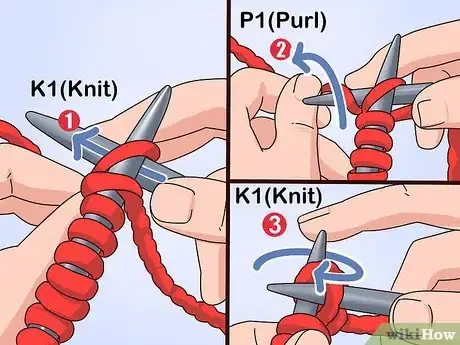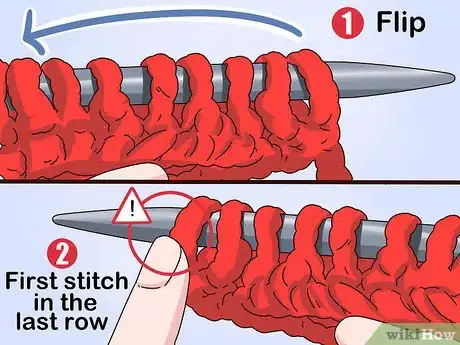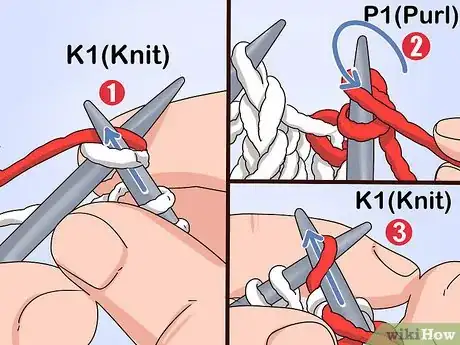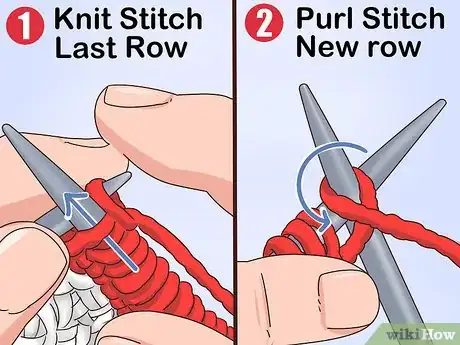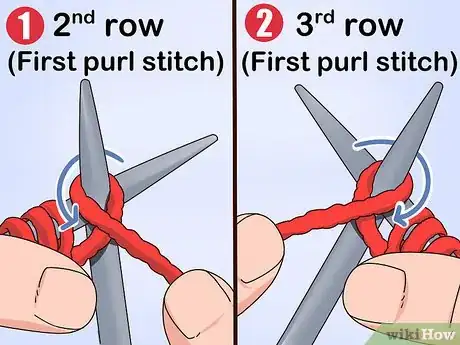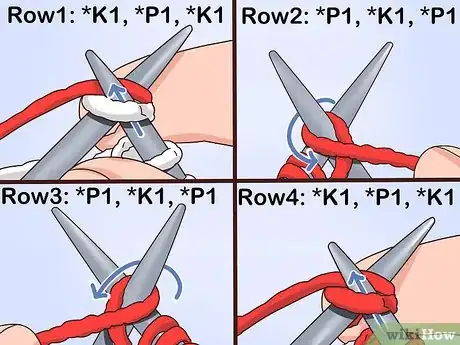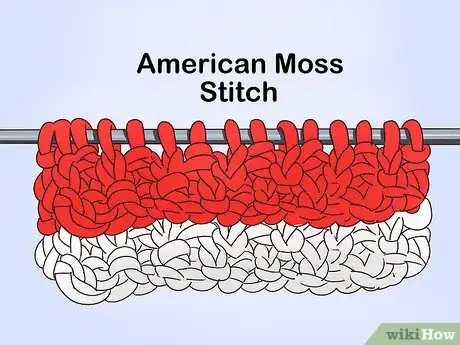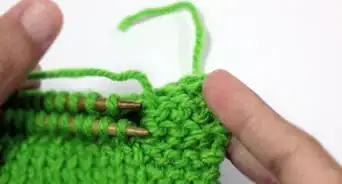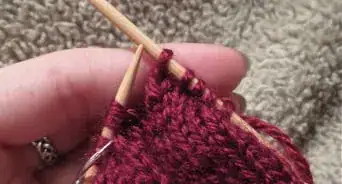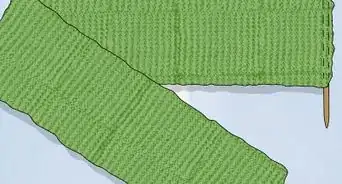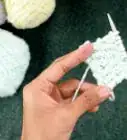This article was co-authored by Jen Webber. Jen Webber is a Knitting Specialist and the Manager of The Quarter Stitch, a crafting store based in the French Quarter of New Orleans, Louisiana. With over 17 years of knitting and crafting experience, Jen helps educate customers and the public on best knitting practices for their DIY projects.
wikiHow marks an article as reader-approved once it receives enough positive feedback. In this case, 93% of readers who voted found the article helpful, earning it our reader-approved status.
This article has been viewed 311,870 times.
The moss and seed stitch both create a piece that has lots of texture to it. The general idea of the moss stitch and a seed stitch are essentially the same, but the terminology might vary depending on whether you're using an American or British knitting pattern. The seed stitch and the British moss stitch require you to complete one row of "knit one, purl one", followed by the next of "purl one, knit one", and so on.[1]
However, the American moss stitch requires one row of "knit one, purl one", followed by two rows of "purl one, knit one", and then a last row of "knit one, purl one," before you repeat the pattern again.[2]
Using these stitches only requires basic knitting skills, such as casting on, knitting stitches, purling stitches, and casting off. If you are skilled at these knitting techniques, then the moss stitch should be no problem for you, but you can always brush up on the basics first.
Steps
Knitting the Seed Stitch or British Moss Stitch
-
1Cast on the number of stitches that you will need to complete your project. If you are just practicing, cast on 10 stitches.
-
2Do your first row by alternating between knitting one stitch and purling the next. Continue alternating between knitting and purling stitches until you reach the end of the row. Remember to place your yarn either in front or behind the stitch you are making so that the yarn is in the correct position to either knit or purl.[3]
- Knitting patterns may describe the first row of the seed stitch as K1, P1, K1, (*repeat to end of row). The “K” stands for knit and the “P” stands for purl.[4]
Advertisement -
3Check the stitch type before starting your second row. Before you begin your next row, check the first stitch. If your last stitch was a knit stitch on the last row, then purl that stitch on the new row. If your last stitch on the previous row was a purl stitch, then knit that stitch on the new row. Then continue alternating stitch types as before.[5] As you continue, just remember to:[6]
- Purl your knit stitches. Knit stitches look flatter and have a criss-cross pattern.
- Knit your purl stitches. Purl stitches stick out more and they do not have a criss-cross pattern.
-
4Continue in this two-row pattern until you are finished. Keep checking the stitch type when you start a new row and alternating as you continue the rows until you are finished with your project.[7]
Knitting the American Moss Stitch
-
1Cast on the number of stitches that you will need to complete your project. You must choose an odd number of stitches in order to successfully knit using the American moss stitch.
-
2Do your first row by alternating between knitting one stitch and purling the next. Continue alternating between knitting and purling stitches until there is one stitch remaining on your left needle. Knit the final stitch, making sure it mirrors the first on that row (which it should, since you cast on an odd number of stitches).
- Remember to place your yarn either in front or behind the stitch you are making so that the yarn is in the correct position to either knit or purl.[8]
-
3Check the stitch type before starting your second row. If your last stitch was a knit stitch on the last row, then purl that stitch on the new row. If your last stitch on the previous row was a purl stitch, then knit that stitch on the new row. Then continue alternating stitch types as before.[9]
-
4Tackle the third row with the same stitch order that you did the second row. Where you did a purl stitch in the second row, do another of the same kind; where you did a knit stitch, do another.
-
5Switch back to the stitch order of your first row, for the fourth row. This will complete the set of four rows. In other words, your pattern should be:
- Row 1: * K1, P1 * K1
- Row 2: * P1, K1 * P1
- Row 3: * P1, K1 * P1
- Row 4: * K1, P1 * K1
-
6Repeat this four-row pattern until you're done with your garment or this part of your pattern. The end result should be something similar to the seed stitch but more elongated.
Expert Q&A
-
QuestionHow do you do a seed or moss stitch?
 Jen WebberJen Webber is a Knitting Specialist and the Manager of The Quarter Stitch, a crafting store based in the French Quarter of New Orleans, Louisiana. With over 17 years of knitting and crafting experience, Jen helps educate customers and the public on best knitting practices for their DIY projects.
Jen WebberJen Webber is a Knitting Specialist and the Manager of The Quarter Stitch, a crafting store based in the French Quarter of New Orleans, Louisiana. With over 17 years of knitting and crafting experience, Jen helps educate customers and the public on best knitting practices for their DIY projects.
Knitting Specialist It's basically an alternating knit-purl pattern. If you line up all your knits and purls, it turns into ribbing, but if you alternate them on the rows, it turns into the seed stitch. The trick is when you get to the end of the row and you turn the piece over, if you're seeing a purl stitch, then you'll start with a knit stitch, and vice versa.
It's basically an alternating knit-purl pattern. If you line up all your knits and purls, it turns into ribbing, but if you alternate them on the rows, it turns into the seed stitch. The trick is when you get to the end of the row and you turn the piece over, if you're seeing a purl stitch, then you'll start with a knit stitch, and vice versa. -
QuestionHow can I increase stitches and not lose the moss stitch pattern?
 Community AnswerIncrease on the end of rows, and keep that increase in mind when you start the next row.
Community AnswerIncrease on the end of rows, and keep that increase in mind when you start the next row. -
QuestionHow do I count seed stitch rows?
 RobinKnightCommunity AnswerAlways have a slide-on row counter at the end of your needle, and alter the row count on each wrong-side row, i.e. every second row. To check the number of rows, count those in twos as well. Count a vertical row of purl stitches from start to finish, each purl is another "2".
RobinKnightCommunity AnswerAlways have a slide-on row counter at the end of your needle, and alter the row count on each wrong-side row, i.e. every second row. To check the number of rows, count those in twos as well. Count a vertical row of purl stitches from start to finish, each purl is another "2".
Warnings
- Supervise young children when handling pointed knitting needles.⧼thumbs_response⧽
Things You'll Need
- Two knitting needles
- Yarn
References
- ↑ http://www.creativeknittingmagazine.com/blog/?p=827
- ↑ http://www.creativeknittingmagazine.com/blog/?p=827
- ↑ https://www.youtube.com/watch?v=Gm5Od4Y9R90
- ↑ http://www.knittingonthenet.com/stitches/seed.htm
- ↑ Jen Webber. Knitting Specialist. Expert Interview. 4 August 2020.
- ↑ https://www.youtube.com/watch?v=Gm5Od4Y9R90
- ↑ https://www.youtube.com/watch?v=Gm5Od4Y9R90
- ↑ https://www.youtube.com/watch?v=Gm5Od4Y9R90
- ↑ http://www.knittingonthenet.com/stitches/seed.htm
- Videos provided by CreatiKnit
About This Article
The British moss and seed stitches are basic knitting techniques where you alternate between knitting and purling. Start by casting the number of stitches you need onto your needle. Then, for your first row, alternate between knitting and purling stitches. When you finish the row, start the next one with the opposite of the last stitch you made. For example, if you finish a row on a stitch, start the next with a purl so that you’ll purl your knit stitches and knit your purl stitches. Continue knitting and purling your stitches until you reach the end. For more tips, including how to knit the American variation of the moss stitch, read on!
